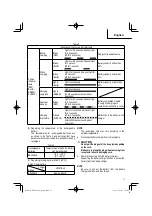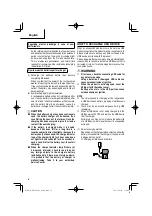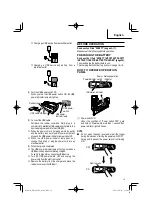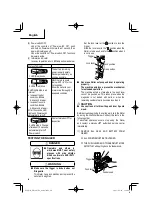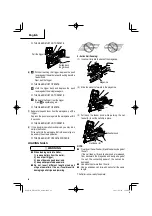
8
English
series. Other type of batteries may burst causing
personal injury and damage.
4. Use of an attachment not recommended or sold by
the battery charger manufacturer may result in a risk
of
fi
re, electric shock, or injury to persons.
5. To reduce risk of damage to electric plug and cord,
pull by plug when disconnecting battery charger.
6. Make sure cord is located so that it will not be stepped
on, tripped over, or otherwise subjected to damage or
stress.
7. An extension cord should not be used unless
absolutely necessary. Use of improper extension
cord could result in a risk of
fi
re and electric shock.
If extension cord must be used make sure:
a. That blades of extension cord are the same
number, size, and shape as those of plug on
battery charger;
b. That extension cord is properly wired and in good
electrical condition; and
c. That wire size is large enough for AC ampere
rating of battery charger as speci
fi
ed in Table 1.
SAFETY
—
Continued
36. Always point probe away from yourself and
others.
Keep your face, hands, feet and other body parts, as
well as those of other persons away from the
fi
ring
head to avoid possible injury during use and carrying.
IMPORTANT SAFETY INSTRUCTIONS
FOR BATTERY CHARGER
WARNING
Death or serious bodily injury could result from
improper or unsafe use of battery chargers.
To avoid these risks, follow these basic safety
instructions:
READ ALL INSTRUCTIONS
1. This manual contains important safety and operating
instructions for battery charger Model UC18YSL3.
2. Before using battery charger, read all instructions
and cautionary markings on (1) battery charger, (2)
battery, and (3) product using battery.
3. To reduce risk of injury, charge metabo HPT
rechargeable battery multi volt type series and BSL18
Table 1
RECOMMENDED MINIMUM AWG SIZE FOR
EXTENSION CORDS FOR BATTERY CHARGERS
AC Input Rating Amperes*
AWG Size of Cord
Equal to or
greater than
but less
than
Length of Cord, Feet (Meter)
25 (7.5)
50 (15)
100 (30)
150 (45)
0
2
18
18
18
16
2
3
18
18
16
14
3
4
18
18
16
14
* If the input rating of a battery charger is given in watts
rather than in amperes, the corresponding ampere
rating is to be determined by dividing the wattage rating
by the voltage rating–for example:
1,250 watts
= 10 amperes
125 volts
8. Do not operate battery charger with damaged cord or
plug-replace them immediately.
9. Do not operate battery charger if it has received a
sharp blow, been dropped, or otherwise damaged in
any way; take it to a quali
fi
ed serviceman.
10. Do not disassemble battery charger; take it to a
quali
fi
ed serviceman when service or repair is
required. Incorrect reassembly may result in a risk of
electric shock or
fi
re.
11. To reduce risk of electric shock, unplug charger from
receptacle before attempting any maintenance or
cleaning. Removing the battery will not reduce this
risk.
000Book̲NR3665DA̲metabo.indb 8
000Book̲NR3665DA̲metabo.indb 8
2021/02/22 12:20:24
2021/02/22 12:20:24

















